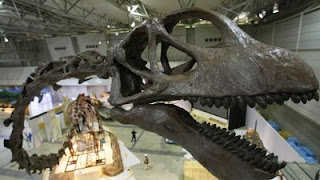 New mounted skeleton of Mamenchisaurus, in Tokyo, the longest mounted dinosaur skeleton in the world. Image by Shiziuo Kambayashi from the AP.
New mounted skeleton of Mamenchisaurus, in Tokyo, the longest mounted dinosaur skeleton in the world. Image by Shiziuo Kambayashi from the AP.What is it about pissing contests over the largest dinosaurs? Who cares if Spinosaurus is a few metres longer than Tyrannosaurus? Does it really matter which super long-necked, long tailed giant sauropod is slightly longer than its nearest competitor?
Of course it does!
Well not really, but it can be a fun part of armchair paleontology to keep track of these things. I created the Wikipedia article Dinosaur Size to try and help people keep tabs on this issue using peer-reviewed sources (though for a while there a few too many Internet sources were creeping in, but we've put a stop to that).
Now, everyone gets their shorts in a bunch over the biggest theropod, because even though sauropods are nearly always bigger, they're not the ones who will try to eat Jeff Goldblum. This is evidenced by the fact that one of the biggest theropods in terms of sheer mass, Therizinosaurus, is almost always ignored in these competitions because it was probably herbivorous and looked like a giant porcupine goose with a beer belly. However, despite how cool theropods may be (i.e., extremely cool), sauropods are without a doubt the group where we find the largest dinosaurs.
So which dinosaur was largest? Well, define large. Do you mean length, height, or mass? In modern animals, mass is usually what counts. The African elephant is considered the largest land animal, even though the giraffe is taller and the reticulated python is longer. The most massive, and therefore largest, dinosaur known from decent remains that still exist is a bit of a tie game right now. Traditionally, the largest sauropod known is cited as the titanosaur Argentinosaurus, with rational mass estimates ranging between 78 and 83 tonnes. However, several other titanosaurs were about the same size, if not bigger, including Puertasaurus and the horrifically named Futalognkosaurus (note that the official name even includes a misspelling, yikes!).

Scale diagram showing several of the largest dinosaurs discussed in this post. Green: Diplodocus. Orange: Supersaurus. Purple: Argentinosaurus. Blue: Sauroposeidon. Grey: Bruhathkayosaurus. Red: Amphicoelias. Scale bar = 40m. Image by Matt Martyniuk, licensed.
The new goss here though, to finally get to the reason for this post, is that the record for longest dinosaur has changed... sort of (see final paragraph, below). When I was a kid, I was enthralled by the longest known dinosaur according to several of my books, the "Seismosaurus" (earthquake lizard). This monster diplodocid (whip-tailed sauropod) was said to be over 130ft in length. Well, those initial estimates were a little too hopeful, and based on the mis-identification of a tail bone which threw the estimates off by up to 30%. More reasonable estimates place its total length at a mere 33.5m (110ft), and furthermore, it turned out to likely be just a slightly oversize specimen of Diplodocus anyway.
The downsizing of Seismo--er, Diplodocus left the length champion to its cousin, Supersaurus. As the preparation of a fairly complete skeleton nicknamed "Jimbo" by Scott Hartman showed, Supersaurus probably reached a total length of 34m, or 112ft, surpassing both Diplodocus and weight champion Argentinosaurus by a meter or two (in the process robbing the titanosaurs of their clear victory in both units of measure).
However, now a new champion emerges by a neck (I'll be here all weekend folks!). A new specimen of the mega-necked Chinese sauropod Mamenchisaurus unearthed in 2001 was initially reported as the largest of its kind at a respectable, but short, 30m (98ft). However, a surprise came when they assembled a reconstructed skeleton for a new exhibition opening in Tokyo: the specimen actually measures a whopping 35m long, or 115ft, beating out Supersaurus for the title of longest known dinosaur. See photo at top of this post.
 Extraordinarily accurate (down to the scales) illustration on Mamenchisaurus by Steve OC, licensed.
Extraordinarily accurate (down to the scales) illustration on Mamenchisaurus by Steve OC, licensed.That is, if you don't count Amphicoelias. This monster, known from a single partial vertebrae that was 8ft tall and would have been 12 if complete, was very similar to Diplodocus and, scaling up from the same bone in that animal, Amphi would have been at the very least 40m long (131ft) and probably in the area of 120 tons, easily trumping all other contenders in every category: length, weight, and height (read the Wiki I started and wrote most of on Amphi here). So far the only contender to that throne is the even more dubious Bruhathkayosaurus, which is known from a poorly preserved, poorly published, and basically never studied leg bone sometimes thought to be a tree trunk, and even if the size the describers said it was is probably vastly overestimated in published surveys. For now, Amphi is the king, but its smaller cousins with better remains are inching closer.

